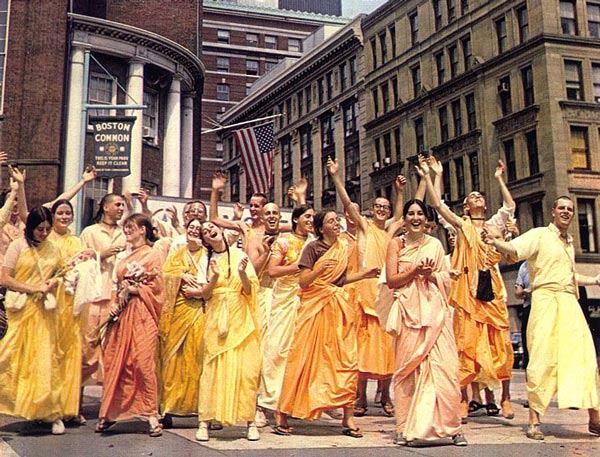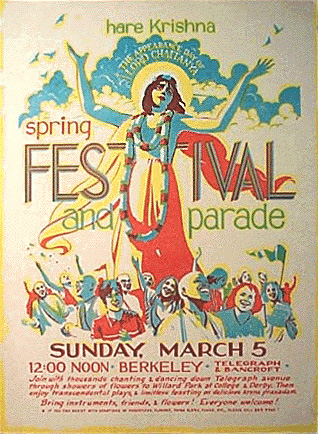

If you think that Hare Krishnas disappeared when the Age of Aquarius ended, look in the next cubicle- they may be working in your office, wearing a suit, with a full head of hair. This week the Hare Krishnas celebrate their 40th anniversary, and they've joined the American mainstream.
Whereas devotees formerly were discouraged from maintaining ties with the outside world, including their own families, Hare Krishnas today mix and mingle like anyone else and don robes and Sanskrit names only while at temple for services. And they don't do airports much anymore. "It's entirely possible these days that a Hare Krishna could be living next door to you and you wouldn't know it," says Burke Rochford, a Middlebury College professor and author of the forthcoming "Hare Krishna Transformed." "They're just now part of the culture in ways that the average person couldn't have imagined some 20 or 25 years ago."
Take Paul Swinford. A 1993 convert, he took the name Premananda Dasa and spent a decade living in Boston's Hare Krishna temple, eventually serving as community leader and pastor. Two years ago, at age 40, he got married, moved out of the Temple to New Hampshire--where his wife works for a financial services company--and recently took an outside job, the first time he's been drawing a paycheck in years. And after waking up in the temple for 10 years, he now drives 90 miles to get there.
His story is typical. Only 750-900 devotees lived in Hare Krishna temples in America by 2000, compared to roughly 3,000 in its mid-1970s heyday, according to Rochford. Today, in Washington, D.C., only 15 people live in the temple, down from 35 in 1980--but about 400 people attend weekly services--a number bolstered across the country by the increasing, and unprecedented, attendance of Indian immigrants looking for a Hindu, not specifically Hare Krishna, worship. In total, the movement runs 400 temples worldwide and claims 1 million adherents, 100,000 in the U.S.--about four times what it was in the 1980s (scholars believe the numbers to be smaller).

Founded in 1966 by A.C. Bhaktivedanta Swami Prabhupada, the movement--formally known as the International Society for Krishna Consciousness (ISKCON)-the Hare Krishnas became largely known for proselytizing in airports and their influence on the Beatle, George Harrison. Based on the teachings of 15th-century philosopher Caitanya Mahaprabhu, Hare Krishnas worship by repeatedly chanting God's name. They believe in simple living and are prohibited from eating meat, gambling, intoxication and sex outside marriage. They were denounced by some parents as a cult, though scholars say it represents an orthodox version of Hinduism. At today's temples, young people in jeans and t-shirts worship alongside middle-aged white men in saffron robes and Indian immigrants in flowing saris. ISKCON communities now offer premarital counseling, participate in interfaith activities, run social service programs, and offer babysitting--just the kind of institutionalization early converts were fleeing.
"We're addressing the needs of our kids for Sunday School, and parking lots, and playgrounds," says Anuttama Dasa, a leader and spokesman. "You don't need playgrounds if your whole community is 20-year-olds. You may not need marriage counseling. You may not need to deal with a lot of the different kinds of social issues that churches and synagogues all over the country deal with."
ISKCON's maturation was sparked partly by these changing needs--and partly by an exodus of members in the wake of serious challenges, including schisms, leadership crises, and questions about keeping kids in the fold. Worst of all, several teachers and spiritual leaders were accused of sexually and physically molesting students in ISKCON boarding schools in the 1970s and '80s while superiors looked the other way. In response to the scandal and resulting lawsuit, ISKCON declared bankruptcy to avoid being shut down by litigation and agreed to pay $9.5 million to several hundred victims, though litigation--and criticism of ISKCON's handling of the scandal--continues. "Speaking as a member of the first generation, we made a lot of mistakes," Anuttama says.
Those mistakes soured many devotees on the movement, while many of those that stayed set out to radically change it--though many victims and their supporters say ISKCON must do more to help the victims, and especially, to discipline the perpetrators, some of whom continue to serve in leadership positions. Around 700 alumni of ISKCON schools where abuse took place have signed a petition advocating a policy of zero-tolerance for child-abusers, in which "confirmed" child abusers would be barred from leadership positions in ISKCON.
Not all defectors left the fold entirely, though. Many former ISKCON members are today living what they call "Krishna conscious" lifestyles, adhering to Hare Krishna rules and beliefs without affiliating with the organization, or affiliating with new Krishna-focused groups. At the same time, much of what made the Hare Krishnas stand out as unusual in the '60s and '70s has become part of mainstream American spirituality, including yoga, vegetarianism, chanting, and concepts like karma and reincarnation. "A lot of people on the streets now believe in those things," Anuttama says. "A lot of things that were considered outlandish or threatening are now taking place in the basement of Christian churches."